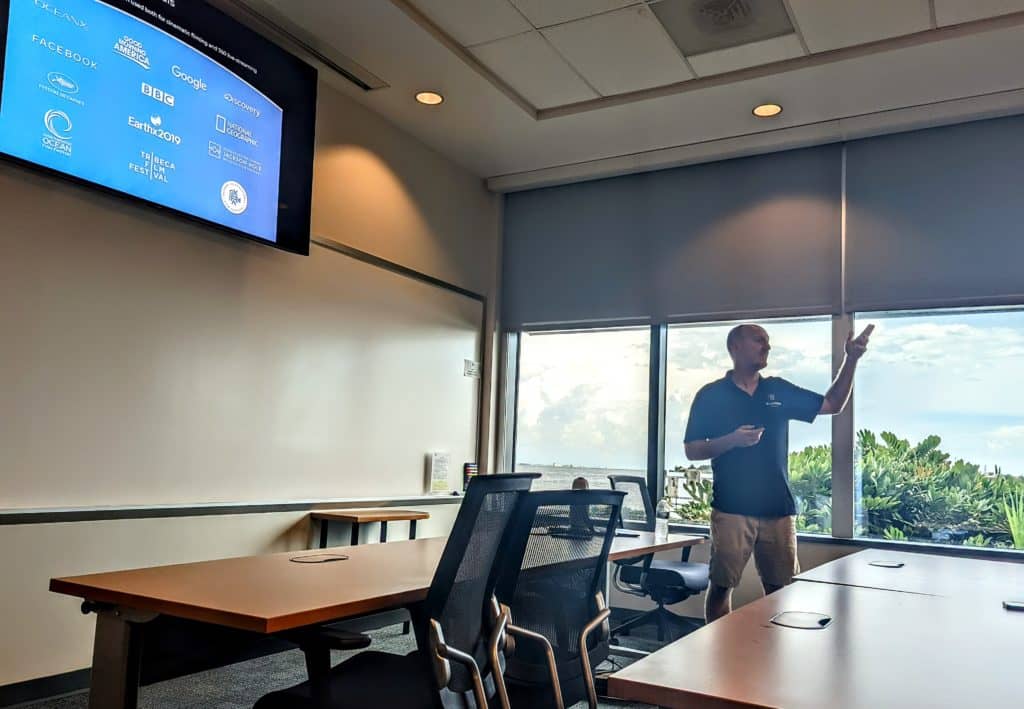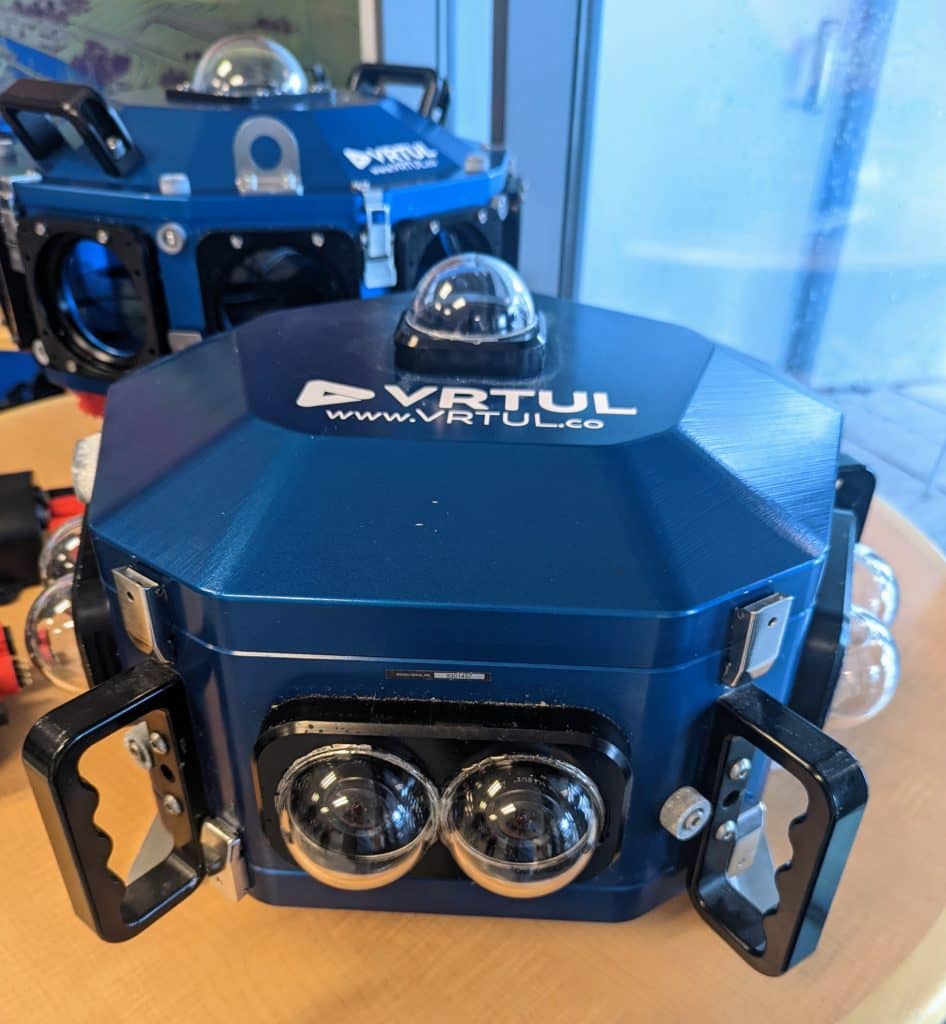Innovate
St. Pete company develops underwater vehicle cameras

Cutting-edge technology continues to emanate from St. Petersburg’s Maritime and Defense Technology Hub, with Blue Ring Imaging showcasing its latest underwater 3D visualization and vehicle control equipment Tuesday.
Blue Ring Imaging (BRI) develops augmented and virtual reality (AR/VR) human-machine interfaces for remotely operated vehicles (ROVs), submersibles and ships from its headquarters at the Hub. Its specialized, 360-degree 3D cameras are custom built according to the vehicle type and mission.
Combined with BRI’s 3D spatial interfaces and data collection for unmanned vehicles, the company provides reality-as-a-service to a wide range of industries, including the Department of Defense, movie production studios and deep-sea science and exploration. During Tuesday’s Tech X-change at the Hub, Casey Sapp, CEO of Blue Ring, explained his company’s background and latest projects and provided hands-on demonstrations of the technology on the Innovation District’s waterfront.
“The whole idea is how – with zero latency – do you get 360 (degrees) and 3D perception into this headset in order to have situational awareness,” said Sapp. “So that you feel the vehicle.”

Blue Ring’s specialized, 360-degree 3D cameras are custom built according to the vehicle type and mission.
While BRI mainly focuses on defense applications these days – Sapp noted he was traveling to San Diego to speak to military officials this week – the company got its start in Hollywood.
Sapp said he started creating VR experiences about 10 years ago, working with film and television producers to tell stories and create cinematic pieces. Calling it the wild west, Sapp said he was building cameras and software previously nonexistent on the headsets and “holding things together with rubber bands, gum and paper clips.”
BRI first operated under the name VRTUL (Virtual Reality Technology Underwater Limited), and Sapp worked with producers from the BBC, National Geographic and Discovery.
According to Blue Ring’s website, Sapp’s inventions include the first 360 3D underwater camera system, the first underwater 360-degree live broadcast for Good Morning America, the first ROV VR piloting system and the highest resolution underwater cinematic camera system in the world, the MSG Sphere.
“If you’ve seen an underwater 360 video, I probably either helped film it or those cameras are out there,” said Sapp.

During Tuesday’s Tech X-change at the Hub, Casey Sapp, CEO of Blue Ring, explained his company’s background and latest projects.
Sapp said his cameras still possess some of the highest resolutions in the world. The MSG Sphere at the Venetian in Las Vegas built a nearly 4-acre, high-resolution LED screen that Sapp said is 25 times bigger than an IMAX screen.
“And this camera is one of the camera systems that was used to shoot film for that screen,” he added.
Sapp said he also recently worked with SeaWorld Abu Dhabi – set to become the world’s largest aquarium – for an enormous screen.
However, Sapp said those were “one-off” projects, not the technological applications he wanted his company to provide. So, he partnered with the Monterey Bay Aquarium Research Institute to ascertain how BRI could make life easier for operators of multimillion-dollar underwater vehicles.
“What we found out is that having a headset on, with a wide-angle field of view with 3D perception … helps people that are new operators, experienced operators, on all types of vehicles – it makes things usable and you complete tasks quicker,” he said. “And overall, it’s just a more enjoyable experience than looking at a tablet.”
Sapp said he started pitching his new ideas and receiving defense contracts about three years ago, and business is rapidly expanding. BRI’s technology is now featured on nuclear submarines, ROVs and drones.
“What we’re doing is essentially bringing 3D visualization into all aspects of your personal space. So that you can just have more access to data and be able to make more decisions and have more situational awareness.”
BRI uses different headsets depending on the application. Sapp explained the company uses the Oculus Quest 2 for VR, which completely immerses the user and prevents them from seeing outside the 90-degree field of view. He called it the “best thing on the market” and an “okay headset” for now but said he expects the tech to take “a big leap forward” next year.
Blue Ring uses the Microsoft HoloLens 2 for AR, which he said offers a lower resolution and narrower field of view. However, it allows users to simultaneously see 3D information, their hands and the world around them while wearing the headset.
Sapp called mixed reality “something in between” the two, offering high resolution and a wide field of view. Utilizing the cameras on the outside of the headset, he said someone can receive the necessary information while viewing their surroundings.
“That’s happening later this year, and we’re moving to that,” heexplained. “So, right now, we’re essentially using legacy technology.
“And what you guys are going to experience – is just kind of a taste of the actual kit that we’re putting together for the military, that we’re going to be commercializing next year.”

BRI first operated under the name VRTUL (Virtual Reality Technology Underwater Limited), and Sapp worked with producers from the BBC, National Geographic and Discovery.
The kit that BRI is building for the military, explained Sapp, is an extensible, multi-camera system that several different sizes and types of underwater vehicles can utilize. He said the system provides real-time stitching of the various cameras’ images, with low latency, high resolution and high frame rate “on a very, very small” piece of computer hardware.
The final piece of the military system is a mixed reality app included in the headset, which collects navigational and telemetry information and the data from the underwater vehicle’s sensors.
“That’s kind of the fundamentals of the business, said Sapp. “And then, once we start scaling that to many different types of vehicles, the goal is autonomy. Do unsupervised learning, imitation learning and synthetic simulation – that’s really the business that we want to be in.”
Sapp elaborated that robots could understand images, but to complete manipulation tasks such as reaching out and grabbing something, they must know the objects’ dimensions and geometry.
While devices like Microsoft Connect utilize infrared (IR) sensors with cameras to build 3D models in real-time, Sapp noted that IR does not work underwater. Instead of a robot conducting image classification, BRI wants it to understand its position in space against a wall or a rock.
Although Sapp could not discuss some current contracts in-depth, he said BRI is working with Lockheed Martin on a project related to large subsurface vehicles. The company works with the Navy’s Explosive Ordinance Disposal department and the Air Force’s Guardian Angel division, which focuses on rapidly retrieving people or equipment out of the water before anyone else has the opportunity.
Blue Ring is also collaborating with the Office of Naval Research, who Sapp said, “are the guys that are thinking more like 10 years out, and they’re more of like an academic group.”
“They’re happy with this technology, but now they want to make everything completely hands-free,” said Sapp. “Like how do you control a vehicle through voice and gesture, and like eye-tracking rather than a controller. So, we’re working with them on essentially all of that.”







